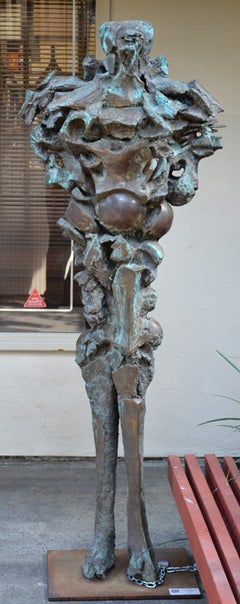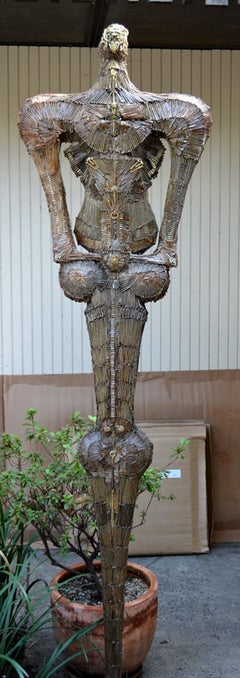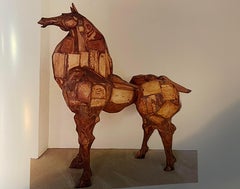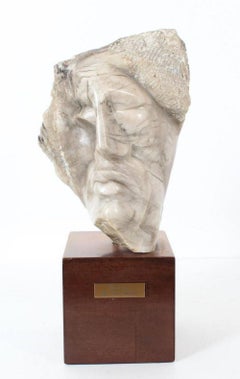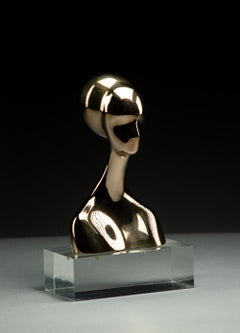Maxine Kim Stussy Art
to
3
Overall Width
to
Overall Height
to
3
1
1
1
3
1
1
2
1
1
3
8,826
2,810
1,649
1,315
3
Artist: Maxine Kim Stussy
Walking Man
By Maxine Kim Stussy 1
Located in West Hollywood, CA
Maxine Kim Stussy, a prolific sculptor and painter from the late 1940’s to present. Maxine led an incredibly artistic life traveling the world with h...
Category
1970s Modern Maxine Kim Stussy Art
Materials
Bronze
The Guardian
By Maxine Kim Stussy 1
Located in West Hollywood, CA
Maxine Kim Stussy was a prolific sculptor and painter from the late 1940’s to present. Maxine led an incredibly artistic life traveling the world with her husband at the time, artist Jan Stussy, who headed the art department at UCLA for several decades. Both artists were close associates of Stanton MacDonald Wright, known as one of the greatest American modernist artists, also known as the co creator of the synchronistic movement in the teens with Marcel Duchamp.
Maxine was unrestricted by any singular medium; her sculptures took form in wood assemblage, concrete, bronze and unique nail assemblage. Large size seemed natural to her, and she often created figurative sculpture over 7 feet high. The gallery has represented the original sculpture of Maxine Kim Stussy for many years, and this is the first time we have presented any of her original works on 1st Dibs.
“The Guardian...
Category
1960s Modern Maxine Kim Stussy Art
Materials
Metal
Maximus: Circus Horse
By Maxine Kim Stussy 1
Located in West Hollywood, CA
We are proud to present a lifetime masterpiece by American artist Maxine Kim Stussy.
“Maxumus: Circus Horse”, is an original wood assemblage of both ha...
Category
1950s Modern Maxine Kim Stussy Art
Materials
Wood
Related Items
Windswept Face Of A Man Marble Sculpture
Located in Lake Worth Beach, FL
Windswept Face Of A Man Marble Sculpture
Signed, on wooden base.
Leon Saulter (1908 - 1986) was active/lived in California born in Poland. Moved to US in 1921. Leon Saulter is known for sculptures, paintings also writer.
Born in Poland on March 31, 1908. By the 1930s, Saulter was active on the Federal Art Project while a resident of Los Angeles.
Exhibitions:
Painters & Sculptors of LA, 1936-40;
Artists Union (LA), 1939;
Stendahl Gallery (LA), 1941;
LACMA, 1940, 1943, 1946
Santa Barbara Museum; Bonita Union High School (Spirit of Youth Learning Industry); David Starr Jordan School, Long Beach (Head).
Museums:
University of Wyoming Art...
Category
1970s Modern Maxine Kim Stussy Art
Materials
Marble
David Hostetler Polished Bronze Female Form Bust Feminine Shiny Gold Egyptian
By David Hostetler
Located in Nantucket, MA
This polished bronze bust is sealed with Glasurit- a car finish that is baked on. It prevents the sculpture from tarnishing or yellowing. All you need to do is dust with a soft cloth. This bust is from a full figure wood sculpture...
Category
1970s Modern Maxine Kim Stussy Art
Materials
Bronze
$5,900
H 11.5 in W 7 in D 4 in
Israeli Bronze Sculpture Lovers Embrace Abstract Modernist Ein Hod Israel
By Gedalia Ben Zvi
Located in Surfside, FL
Bronze sculpture signed in Hebrew and numbered from small edition of 6
BIOGRAPHY
"I was born in Czechoslovakia in the year 1925, of traditional parents. I spent my youth partly in ...
Category
Mid-20th Century Modern Maxine Kim Stussy Art
Materials
Bronze
$1,800
H 17 in W 10 in D 8.5 in
Hattakitkosol Somchai Art Bronze Bird Sculpture, circa 1980
By Hattakitkosol Somchai
Located in Atlanta, GA
Soar into the realm of timeless artistry with this magnificent gilded bronze sculpture by celebrated Thai artist Hattakitkosol Somchai (1934–2000)—a commanding representation of a bi...
Category
1990s Modern Maxine Kim Stussy Art
Materials
Bronze
$1,700
H 16.94 in W 3.94 in D 4.75 in
"Couple II" Mid 20th Century Modern Abstract Figurative 1940s European Sculpture
By Jacques Lipchitz
Located in New York, NY
"Couple II" Mid 20th Century Modern Abstract Figurative 1940s European Sculpture
Jacques Lipchitz (1891-1973)
"Couple II"
Bronze
signed on the base
The sculpture was conceived in 19...
Category
1940s Modern Maxine Kim Stussy Art
Materials
Bronze
$75,000
H 8 in W 8 in D 5 in
Woman Lying Down & Growing with Tree bronze sculpture by Yulla Lipchitz
Located in Hudson, NY
Organic, abstract bronze sculpture by Yulla Lipchitz of a woman lying down with a tree.
About this artist: Yulla Lipchitz, née Halberstadt, was born on April 21, 1911 in Berlin, Ge...
Category
1970s Modern Maxine Kim Stussy Art
Materials
Bronze
$3,775
H 16 in W 7 in D 8 in
Israeli Mod Arts & Crafts Copper Sculpture Bookends Bezalel Schatz Yaad Studio
By Bezalel Schatz
Located in Surfside, FL
Bezalel Schatz, (1912-1978), Yaad Studio Workshop
Mid century modern
The standing part is 6 X 5 inches. The copper sheet is 10 X 5 inches each. This is for a pair. they are copper w...
Category
Mid-20th Century Modern Maxine Kim Stussy Art
Materials
Copper
Bronze Abstract Space Age Book Sculpture LA California Modernist Charna Rickey
By Charna Rickey
Located in Surfside, FL
Charna Rickey 1923 - 2000 Mexican-American Jewish Woman artist.
Signed Bronze House of Books, Architecture Bronze sculpture, signed Charna Rickey and on the front "House of the book." It depicts an open Torah. Original patina.
Approx. dimensions: 7 in. H x 9 in. W x 8.5 in. D. Weight: 13.1 lbs.
Modernist Judaica Sculpture
Born Charna Barsky (Charna Ysabel or Isabel Rickey Barsky) in Chihuahua, Mexico, the future artist lived in Hermosillo and immigrated to Los Angeles when she was 11. She was educated at UCLA and Cal State L.A., she married furniture retailer David Rickey and explored art while raising their three daughters. Moving through phases in terra cotta, bronze, marble and aluminum, she found success later in life. Rickey became one of the original art teachers at Everywoman's Village, a pioneering learning center for women established by three housewives in Van Nuys in 1963. She also taught sculpture at the University of Judaism from 1965 to 1981.
As Rickey became more successful, her sculptures were exhibited in such venues as Artspace Gallery in Woodland Hills and the Courtyard of Century Plaza Towers as part of a 1989 Sculpture Walk produced by the Los Angeles Arts Council. Her sculptures have also found their way into the private collections of such celebrities as Sharon Stone.
Another of Rickey's international creations originally stood at Santa Monica College. In 1985, her 12-foot-high musical sculpture shaped like the Hebrew letter "shin" was moved to the Rubin Academy of Music and Dance at Hebrew University in Jerusalem. The free standing architectural Judaic aluminum work has strings that vibrate in the wind to produce sounds. Rickey also created art pieces for the city of Brea. They commissioned some amazing art pieces by Laddie John Dill, Walter Dusenbery, Woods Davy, Rod Kagan, Pol Bury, Niki de Saint Phalle, Magdalena Abakanowicz, Larry Bell, John Okulick...
Category
20th Century American Modern Maxine Kim Stussy Art
Materials
Marble, Bronze
$2,200
H 7 in W 9 in D 8.5 in
Bronze Bowl With Marble and Wood Sculpture
Located in Lake Worth Beach, FL
Bronze Marble Wood Sculpture
Four separate pieces, unsigned artist Sarah Schwartz was born 1953 Chicago, Illinois.
Education: 1971-72 York University/Ontario College of Art, Toronto...
Category
1980s American Modern Maxine Kim Stussy Art
Materials
Marble, Bronze
After Alberto Giacometti, Woman Standing Up, Bronze Figure
By Alberto Giacometti
Located in Pasadena, CA
Modern copy bronze with brown patina figural sculpture, after Alberto Giacometti (Swiss, 1901-1966), signed, depicting abstract nude male a figures, in a parcel gilt finish, stan...
Category
1950s Modern Maxine Kim Stussy Art
Materials
Bronze
Latin American Raúl Valdivieso Bronze Organic Abstract Sculpture
By Raúl Valdivieso
Located in Washington, DC
Striking bronze organic sculpture by Latin American sculptor Raúl Valdivieso (Chilean, 1931-1993). Valdivieso is known for his reinterpretation of the ...
Category
1960s Modern Maxine Kim Stussy Art
Materials
Bronze
$1,925 Sale Price
30% Off
H 15 in W 12 in D 8 in
Brutalist Modern Abstract Bronze Sculpture Metropolis Manner of Louise Nevelson
By Abbott Pattison
Located in Surfside, FL
A very heavy, massive bronze sculpture by an important Chicago sculptor. Signed and marked "Firenze" with "Fuse Marinelli". METROPOLIS. Seven abstract shapes on black marble base. 1...
Category
20th Century Modern Maxine Kim Stussy Art
Materials
Marble, Bronze
$7,500
H 12.5 in W 22.75 in D 12.5 in
Maxine Kim Stussy art for sale on 1stDibs.
Find a wide variety of authentic Maxine Kim Stussy art available for sale on 1stDibs. You can also browse by medium to find art by Maxine Kim Stussy in metal, bronze, wood and more. Much of the original work by this artist or collective was created during the 20th century and is mostly associated with the modern style. Not every interior allows for large Maxine Kim Stussy art, so small editions measuring 16 inches across are available. Customers who are interested in this artist might also find the work of Sorel Etrog, Judy Engel, and Seena Donneson. Maxine Kim Stussy art prices can differ depending upon medium, time period and other attributes. On 1stDibs, the price for these items starts at $45,000 and tops out at $125,000, while the average work can sell for $95,000.
